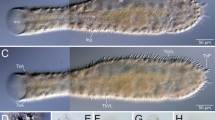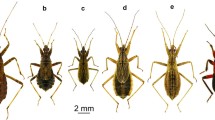Summary
A new multicellular glandular sensory organ is described forCatanema sp. (Nematoda, Stilbonematinae). The organs terminate in setae and are distributed in six longitudinal rows along the body. Two types of glandular cells (type A and type B), one monociliary sensory cell and one undifferentiated epidermal cell are combined in the basiepidermal organ. A comparison of epidermal glands as well as sensory organs in Nematoda is made. A causal relationship between the development of such complex, large and numerous glandular sensory organs and the occurrence of species-specific, symbiotic epibacteria inCatanema sp. seems probable, although there is no simple correlation between the distribution of these organs and epibacteria. A mucous cover over the bacterial layer, released by the glandular sensory organs, may create a microenvironment for the interaction between epibionts and host.
Similar content being viewed by others
Abbreviations
- a :
-
amphid
- A1–A4 :
-
type 1–4 granules of type A gland cell
- an :
-
annuli
- b :
-
bacteria
- B1–B3 :
-
type 1–3 granules of type B gland cell
- bl :
-
basal lamina
- bp :
-
basal part of seta
- bz :
-
basal zone of cuticle
- c :
-
cuticle
- ca :
-
canal
- cg :
-
caudal gland
- ci :
-
cilium
- cz :
-
cortical zone of cuticle
- d :
-
dictyosomes
- e :
-
epidermis
- e co :
-
extracellular coat
- em :
-
extracellular matrix
- ep :
-
epicuticle
- f :
-
filaments
- gcA :
-
type 1 gland cell
- gcB :
-
type 2 gland cell
- i lp :
-
inner labial papillae
- m :
-
mitochondrion
- me :
-
membranes of type 2 gland cell
- mo :
-
mouth opening
- mz :
-
median zone of cuticle
- n :
-
nucleus
- nu :
-
nucleolus
- p :
-
process
- pv :
-
primary vesicle of type A gland cell
- r :
-
ribosomes
- s :
-
seta
- sc :
-
sensory cell
- sp :
-
secretory product
- tj :
-
tight junction
- tp :
-
terminal part of seta
- uc :
-
undifferentiated epidermal cell
- va :
-
vacuoles or vesicles of epidermal cells
- ve :
-
vesicles of sensory cell
References
Bird AF (1971) The structure of nematodes. Academic Press, New York London, 318 pp
Bird AF (1984) Nematoda. In: Bereiter-Hahn J, Matoltsy AG, Sylvia Richards K (eds) Biology of the integument. 1. Invertebrates. Springer, Berlin Heidelberg, pp 212–233
Bütschli O (1874) Zur Kenntnis der freilebenden Nematoden, insbesondere der des Kieler Hafens. Abh Senckenb Naturforsch Ges 9:1
Chitwood BG, Chitwood MB (1950) Introduction to nematology. University Park Press, Baltimore London Tokyo, 213 pp
Cobb NA (1920) One hundred new nemas. Contr Sci Nematol 9:217–343
Coomans A (1979a) A proposal for a more precise terminology of the body regions in the nematode. Ann Soc R Zool Belg 108/1–2:115–117
Coomans A (1979b) The anterior sensilla of nematodes. Rev Nématol 2/2:259–283
Coomans A, De Griesse A (1981) Sensory structures. In: Zuckerman BM, Rohde RA (eds) Plant parasitic nematodes. Academic Press, New York London, pp 127–174
Croll NA, Smith JM (1974) Nematode setae as mechanoreceptors. Nematologica 20:291–296
De Conick LA (1965) Classe des Nematodes —Systématique des Nématodes et sous-classe des Adenophorea. In: Grasse: Traité de Zoologie 4/2:586–681
Gerlach SA (1953) Die biozönotische Gliederung der Nematodenfauna an den deutschen Küsten. Z Morphol Ökol Tiere 41:411–512
Hayat MA (1986) Basic techniques for electron microscopy. Academic Press, Orlando San Diego New York, 411 pp
Hopper BE, Cefalu RC (1973) Free-living marine nematodes from Biscayne Bay, Florida V. Stilbonematinae: Contributions to the taxonomy and morphology of the genusEubostrichus Greeff and related genera. Trans Am Microsc Soc 92/4:578–591
Inglis WG (1967) Interstitial nematodes from St. Vincent's Bay New Caledonia. Editions de la Fondation Singer-Polignac, pp 29–74
Kreis H (1934) Oncholaiminae Filipjev 1916. Eine monographische Studie. Capita Zool 4/5:1–271
Lee DL (1977) The nematode epidermis and collagenous cuticle, its formation and ecdysis. Symp Zool Soc Lond 39:145–170
Lippens PL (1974) Ultrastructure of a marine nematode,Chromadorina germanica (Buetschli, 1874) II. Cytology of lateral epidermal glands and associated neurocytes. Z Morphol Tiere 79:283–294
Lorenzen S (1977) Haftborsten bei dem NematodenHaptotricoma arenaria gen. n.; sp. n. (Desmoscolecidae) aus sublitoralem Sand bei Helgoland. Veröff Inst Meeresforsch Bremerhaven 16:117–124
Lorenzen S (1981) Entwurf eines phylogenetischen Systems der freilebenden Nematoden. Veröff Inst Meeresforsch Bremerhaven Suppl 7:1–472
Maggenti AR (1964) Morphology of somatic setae:Thoracostoma californicum (Nemata: Enoplidae). Proc Helminthol Soc Wash 31/2:159–166
Maggenti A (1981) General nematology. Springer, New York Heidelberg Berlin, 372 pp
McLaren DL (1976a) Nematode sense organs. Adv Parasitol 14:195–265
McLaren DL (1976b) Sense organs and their secretion. In: Croll NA (ed) The organization of nematodes. Academic Press, London New York, pp 139–161
Nicholas WL, Goodchild DJ, Stewart A (1987) The mineral composition of intracellular inclusions in nematodes from thiobiotic mangrove mud-flats. Nematologica 33:167–179
Nuß B (1984) Ultrastrukturelle und ökophysiologische Untersuchungen an kristalloiden Einschlüssen der Muskeln eines sulfidtoleranten limnischen Nematoden (Trobrilus gracilis). Veröff Inst Meeresforsch Bremerhaven 20:3–15
Nuß B, Trimkowski V (1984) Physikalische Mikroanalysen an kristalloiden Einschlüssen beiTrobrilus gracilis (Nematoda, Enoplida). Veröff Inst Meeresforsch Bremerhaven 20:17–27
Ott JA, Novak R (1989) Living at an interface: Meiofauna at the oxygen-sulfide boundery of marine sediments. In:Ryland JS, Tyler PA (eds) Reproduction, genetics and distribution of marine organisms. Olsen & Olsen, Fredensborg, pp 415–422
Schiemer F, Novak R, Ott J (1990) Metabolic studies on thiobiotic free-living nematodes and their symbiontic microorganisms. Marine Biology 106:129–137
Storch V, Welsch U (1972) The ultrastructure of epidermal mucous cells in marine invertebrates (Nemertini, Polychaeta, Prosobranchia, Opistobranchia). Marine Biology 13:167–175
Tyler S (1979) Distinctive features of cilia in metazoans and their significance for systematics. Tissue Cell 11/3:385–400
Van de Velde MC, Coomans A (1989) A putative new hydrostatic skeletal function for the epidermis in monhysterids (Nematoda). Tissue Cell 21/4:525–533
Wright KA (1980) Nematode sense organs. In: Zuckerman BM (ed) Nematodes as biological model systems, vol II Academic Press, New York, pp 237–295
Author information
Authors and Affiliations
Rights and permissions
About this article
Cite this article
Nebelsick, M., Blumer, M., Novak, R. et al. A new glandular sensory organ inCatanema sp. (Nematoda, Stilbonematinae). Zoomorphology 112, 17–26 (1992). https://doi.org/10.1007/BF01632991
Received:
Issue Date:
DOI: https://doi.org/10.1007/BF01632991




